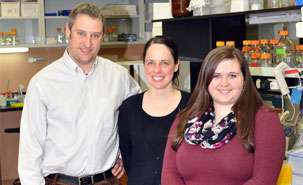Can our bones protect us against diabetes and obesity?

A team of researchers at the IRCM led by Mathieu Ferron, PhD, in collaboration with researchers at Columbia University, discovered a new function of the skeleton associated with diabetes and obesity. The scientific breakthrough, published today in the scientific journal The Journal of Cell Biology, reveals how a hormone produced by bones, and controlled in part by vitamin K, can influence the whole body's energy and glucose metabolism.
Dr. Ferron's team studies osteoblasts, the cells responsible for bone formation. More precisely, the researchers are interested in a hormone produced by these bone cells, called osteocalcin, which is involved in controlling insulin and glucose.
"Our previous work had shown that osteocalcin can improve glucose intolerance in diabetic mice," explains Dr. Ferron, Director of the Integrative and Molecular Physiology research unit at the IRCM. "In fact, we demonstrated this hormone increases the production and secretion of insulin by the pancreas, as well as sensitivity to insulin in peripheral tissue such as muscle and body fat."
According to circumstantial evidence within the scientific community, it was suggested that osteocalcin is controlled by gamma-carboxylation, a process that modifies the hormone's function and relies on vitamin K. To confirm or refute this theory, IRCM researchers studied the enzymes that alter osteocalcin and observed the impact they had on glucose. To do so, they examined mice in which the enzymes responsible for gamma-carboxylation or recycling vitamin K had been inactivated specifically in osteoblasts.
"We confirmed that osteocalcin's hormonal activity relies on vitamin K, which in turn participates in the gamma-carboxylation process," adds Dr. Ferron. "More concretely, when this process is inhibited in osteoblasts, osteocalcin becomes more active, which translates into improved glucose levels and improved sensitivity to insulin that, as a result, protects against type 2 diabetes and obesity."
Combined with their past work, this study allowed the scientists to further understand a new function of the bone, which acts as an endocrine organ by producing a hormone, osteocalcin, to influence energy metabolism and insulin sensitivity.
"While this breakthrough may seem surprising at first, it shows that the bone is similar to many other organs; it is both a receiver and a transmitter of hormonal signals," concludes Dr. Ferron. "A better understanding of the function of osteocalcin could eventually lead to the development of therapies for type 2 diabetes and obesity that would target vitamin K or gamma-carboxylation in osteoblasts."
More information: "GGCX and VKORC1 inhibit osteocalcin endocrine functions" JCB vol. 208 no. 6 761-776. DOI: 10.1083/jcb.201409111


















